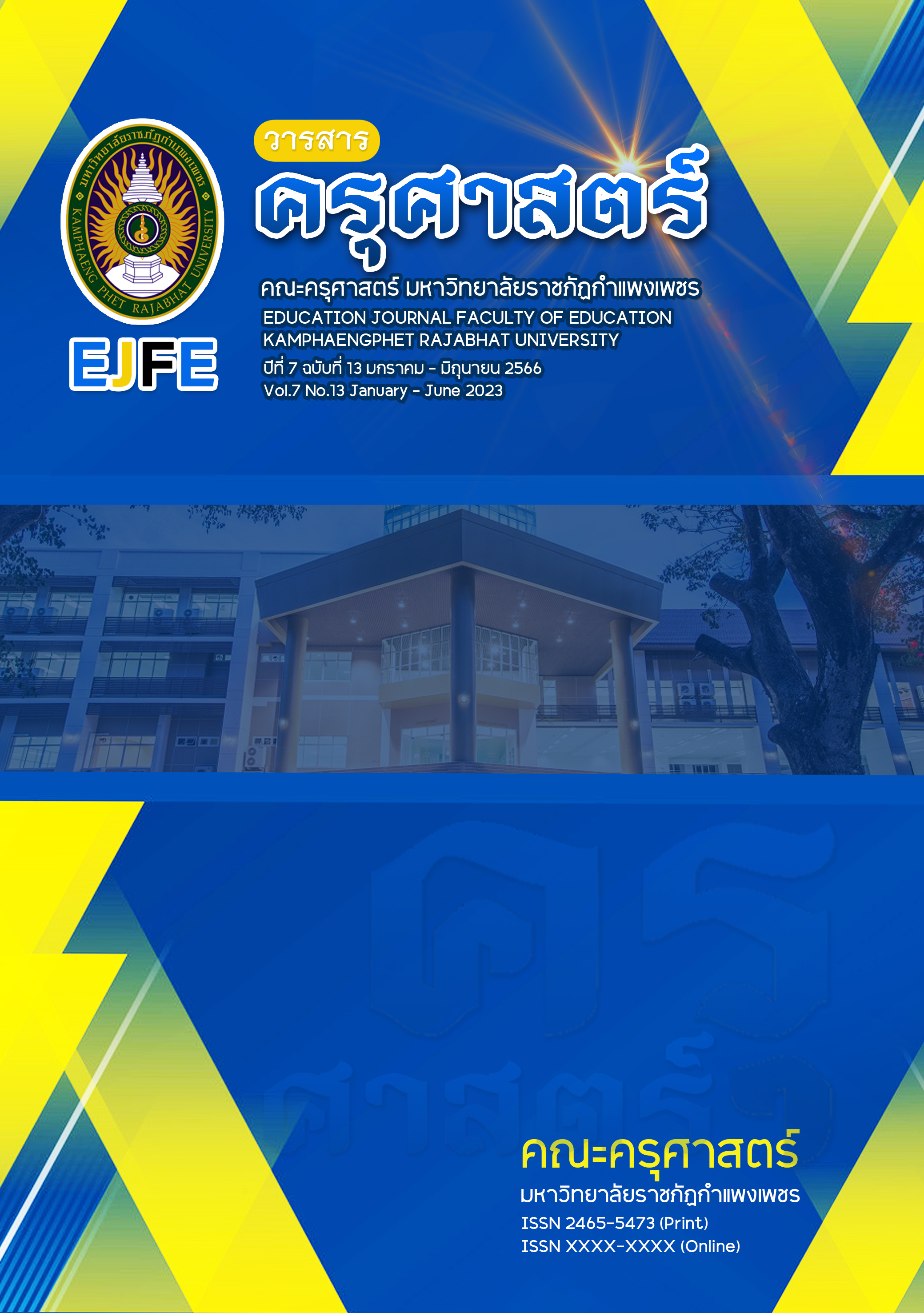Thailand's Strategy for Learning and Teaching from the New Normal to the Next Normal
Main Article Content
บทคัดย่อ
The coronavirus (COVID-19) pandemic has necessitated the adoption of new educational strategies to accommodate the changing circumstances. Among the most prominent strategies are online learning and hybrid models, which provide flexible and personalized learning opportunities. Educators have also adapted their teaching methods, with remote learning and flipped classrooms proving effective in promoting student engagement and collaboration. As we continue to adapt to the New Normal post-COVID-19, it is essential to reassess these learning strategies and provide upskilling opportunities for educators to ensure equitable access to education. Today, we have entered the Next Normal, prompting numerous educators to put forward adaptive learning strategies aligned with current circumstances. Therefore, this paper explores learning and teaching strategies that will aid educators and learners in transitioning from the New Normal to the Next Normal in education. Specifically, it will examine the opportunities presented by the shift to remote learning and digital technologies, along with strategies to ensure quality education for all learners in the Next Normal.
Article Details

อนุญาตภายใต้เงื่อนไข Creative Commons Attribution-NonCommercial-NoDerivatives 4.0 International License.
CC Attribution-NonCommercial-NoDerivatives 4.0
เอกสารอ้างอิง
Al-Qaysi, N., Salloum, S. A., & Al-Emran, M. (2020). The Impact of Hybrid Learning On Students’ Academic Performance: Evidence from Undergraduate Students in Oman. Education Sciences, 10(5), 134.
Beatty, B. J. (2019). Hybrid-Flexible Course Design: Implementing Student-Directed Hybrid Classes. EdTech Books. [Online] Retrieved on March 5, 2023, from https://edtechbooks.org/hyflex
Bonk, C. J., & Graham, C. R. (2012). The Handbook of Blended Learning: Global Perspectives, Local Designs. New York : John Wiley & Sons.
Brusilovsky, P., Sosnovsky, S., & Yudelson, M. (2015). Adaptive and Personalized Technologies for Online Education. In S. Carliner, C. Fulford, & N. Ostashewski (Eds.), Proceedings of EdMedia: World Conference on Educational Media and Technology (pp. 34-43). Association for the Advancement of Computing in Education (AACE).
Cheng, K. H., Wang, Y. S., & Yang, S. J. H. (2021). The effects of Virtual Reality Learning on Learning Performance and Motivation: A Meta-Analysis. Educational Research Review, 33, 100381.
Chen, Y., & Wang, C. (2020). Integrating Virtual Reality into Classroom Teaching: A Case Study of Chinese EFL Teachers’ Beliefs and Practices. Educational Technology & Society, 23(3), 317-327.
Dalgarno, B., & Lee, M. J. W. (2010). What are the Learning Affordances of 3-D Virtual Environments? British Journal of Educational Technology, 41(1), 10-32.
Dudley, B. (2020). Microlearning: The Emerging E-learning Trend. E-learning Industry. [Online] Retrieved on March 10, 2023, from https://arit.kpru.ac.th/sh/a40c08.
Fonseca, D., Sánchez, J., Redondo, E., & Navarro, I. (2020). A Systematic Review of Augmented Reality and Mixed Reality for Education: Advantages and Disadvantages. Educational Research Review, 30, 100326.
Friedman, T. L., & Kahn, R. (2020). The "Next Normal" Arrives: Trends That Will Define 2021--and Beyond. Foreign Affairs, 99(1), 3-9.
Gamage, D. (2021). COVID-19 and Education in Thailand: Challenges, Responses, and Lessons Learned. Journal of Education and e-Learning Research, 8(1), 10-19.
Ghosh, S., & Nundy, M. (2021). The Next Normal: A Global Outlook on Changing Workplaces. Bingley, UK, : Emerald Publishing Limited.
Hew, K. F., & Cheung, W. S. (2013). Use of Blended Learning: Student Perceptions and Factors Affecting Motivation and Learning Satisfaction. Journal of Educational Technology & Society, 16(2), 27-38.
Hsu, H. Y., Chou, C. Y., & Yen, C. H. (2021). Effects of Virtual Reality-Based Instruction on Science Learning Outcomes: A Meta-Analysis. Interactive Learning Environments, 29(1), 113-129.
Huang, H. M., & Liaw, S. S. (2018). Exploring Learners’ Attitudes toward Virtual Reality Learning: A Literature Review and Future Directions. Computers & Education, 126, 89-97.
Kapp, K. M. (2012). The gamification of learning and instruction: game-based methods and strategies for training and education. San Francisco: John Wiley & Sons.
Kumar, S., & Dabbagh, N. (2021). Microlearning: Emerging trends and future directions. Educational Technology Research and Development, 69, 1-10.
Lee, C., & Wong, S. (2020). Virtual Reality Learning: Benefits and Challenges. International Journal of Advanced Research in Education and Society, 2(2), 1-5.
Lin, H. L., Huang, Y. M., & Cheng, S. C. (2020). Current Trends and Future Directions of Virtual Reality Learning Environments: A Review of Journal Articles from 2011 to 2018. Journal of Educational Technology & Society, 23(3), 126-140.
Liu, W., Kong, J., & Luo, L. (2021). Understanding learners’ engagement in virtual reality-based learning: An empirical study. Journal of Educational Technology & Society, 24(2), 354-367.
Ferdig, R.E., Baumgartner, E., Hartshorne, R., Kaplan-Rakowski, R., & Mouza, C. (2020). Teaching, Technology, and Teacher Education during the COVID-19 Pandemic: Stories from the Field. Waynesville, NC. : Association for the Advancement of Computing in Education (AACE).
Pellegrino, J. W., & Hilton, M. L. (2012). Education for life and work: Developing transferable knowledge and skills in the 21st century. National Academies Press.
Pane, J. F., Steiner, E. D., Baird, M. D., Hamilton, L. S., & Pane, J. D. (2017). Continued progress: Promising evidence on personalized learning. Santa Monica, California: RAND Corporation.
Pena, A., & Pitre, E. (2019). A review of hybrid learning: Advantages, disadvantages, and future directions. International Journal of Teaching and Learning in Higher Education, 31(2), 203-213.
Rizvi, S. M. H., & Nizami, M. A. (2018). Virtual Reality Learning: Potential and challenges. Education and Information Technologies, 23(6), 2615-2634.
Rodrigues, L., & Resende, R. (2020). Microlearning: An Overview. In Handbook of Research on Emerging Trends and Technologies in Library and Information Science (pp. 19-30). Hershey, Pennsylvania : IGI Global.
Sirikorn, T., & Saipan, P. (2021). The development of a blended learning model based on the community of inquiry framework: A case study in Thailand. Education and Information Technologies, 26(1), 165-183.
Terantino, J. M., & Hölterhof, T. (2020). Microlearning: Benefits and challenges. Journal of Educational Technology Development and Exchange, 13(1), 1-16.
UNESCO. (2020). COVID-19 educational disruption and response. [Online] Retrieved on March 5, 2023, from https://en.unesco.org/covid19/educationresponse
Wang, Q., & Vásquez, C. (2020). HyFlex Course Design in Higher Education: Advantages, Challenges, and Best Practices. Journal of Education and Learning, 9(4), 341-351.


